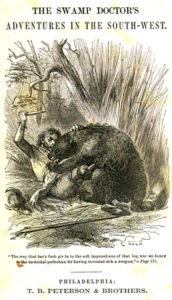Southwestern Humor
Southwestern humor is a literary genre that flourished in the southeastern United States between 1830 and 1865.

Courtesy of University of North Carolina Chapel Hill
"The Swamp Doctors Adventures in the South-West" by Henry Clay Lewis. Lewis, Henry Clay (Author)
Between 1830 and 1865, southwestern humor—also known as antebellum southern humor, southern backwoods or frontier humor, and the humor of the old South—flourished in the southeastern United States. Principally a newspaper phenomenon, southwestern humor sketches and tales were often initially published in local newspapers, including the New Orleans Picayune. Typically these stories featured regional characters speaking in vernacular dialects, sometimes engaging in extraordinary and outlandish activities. Often they depicted a clash between polite and primitive cultures. The writers of southwestern humor were, generally, socially prominent white men—planters, lawyers, judges, physicians, journalists, and politicians. Rarely professional writers, they often wrote anonymously or pseudonymously. This type of literature was popular among both Louisiana readers and writers, including Thomas Bangs Thorpe and Henry Clay Lewis.
Southwestern humor took the form of literary sketches, tall tales, autobiography, letters, almanac pieces, sports reporting, burlesques, and mock sermons. Often a genteel narrator framed the story of more a rustic, less educated character. The subject matter typically addressed topics excluded from early-nineteenth-century romantic and sentimental writing, such as fights, hunting, horseracing, and other sporting events; sermons and camp meetings; courtroom proceedings; con artistry and other forms of roguery; pranks; acts of violence and cruelty; excessive drinking; and gambling.
Though at least fifty amateur writers wrote in the southwestern humor tradition, two Louisiana writers—portrait painter/editor Thomas Bangs Thorpe and frontier physician Henry Clay Lewis—are considered among the most prominent. Thorpe, who moved to Louisiana from New York in 1837, edited or co-edited the Southern Sportsman, Concordia Intelligencer, and Louisiana Conservator, among other papers. He also wrote humorous sketches and tales, of which his 1841 story, “The Big Bear of Arkansas,” is considered prototypical of the genre. Published in the March 27, 1841, issue of the New York Spirit of the Times, this story features a hunt for a mythic bear that has been compared with the hunt for the white whale in Melville’s Moby-Dick. Some of Thorpe’s other humorous sketches were published in collections, The Mysteries of the Backwoods and The Hive of the “Bee-Hunter.”
Henry Clay Lewis, who wrote under the pseudonym Madison Tensas, was the author of the 1850 book Odd Leaves from the Life of a Louisiana “Swamp Doctor,” a collection of twenty-two stories narrated by a backwoods physician. Born in Charleston, South Carolina, Lewis served as a frontier doctor in northeastern Louisiana and often drew on his personal experiences in his fiction. One of the most subversive of the southwestern humorists, Lewis transgressed traditional boundaries of race and gender. His stories, for example, sometimes featured women behaving immodestly, as in “A Tight Race Considerin’.” Typically, he presented a sardonic comical vision, focusing on the grotesque, bizarre, and horrifying. In “The Indefatigable Bear Hunter,” a hunter’s leg is amputated after a bear attack; the hunter then uses his wooden leg to defend himself when another bear attacks him.
Though not as well known or widely published, George Wilkins Kendall and Christopher Mason Haile also worked in the genre. Kendall, who was co-founder and editor of the New Orleans Picayune, reprinted southwestern humor sketches and tales first published elsewhere. Kendall also wrote humorous sketches himself, at least one of which, “Bill Dean, the Texas Ranger,” was initially published in the New York Spirit of the Times in 1846. Kendall further demonstrated his proclivity for humor in Narrative of the Texas Santa Fé Expedition, published in 1844.
A native of Rhode Island, Christopher Mason Haile migrated to Louisiana in the 1830s, where he served as editor of the Plaquemine Planters’ Gazette. His most important contribution to southwestern humor is his series of sixty-seven letters written under the pseudonym Pardon Jones and published in Kendall’s New Orleans Picayune between 1840 and 1848. Partly satiric but mostly amusing, some of the best Pardon Jones letters focus on southern Louisiana topics such as hunting, fishing, local politics, social customs, cultural clashes, and the misadventures of Pardon Jones himself.
Often seen as a precursor of literary realism, southwestern humor influenced many American writers, including Mark Twain, particularly in the Adventures of Huckleberry Finn. The writers of local color fiction, including Joel Chandler Harris, Charles Waddell Chesnutt, Mary Noailles Murfree, Sherwood Bonner, and Ruth McEnery Stuart were also influenced, as were modernists like William Faulkner, Erskine Caldwell, Flannery O’Connor, Eudora Welty, Roy Blount, Jr., Cormac McCarthy, and others.
